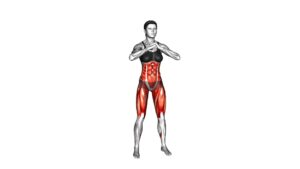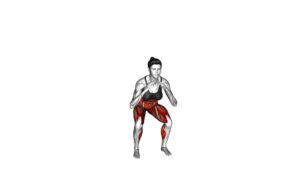Squat Side Power Kick – Video Exercise Guide & Tips

Are you looking to level up your lower body workouts? Look no further than the Squat Side Power Kick!
Watch This Exercise Video
This explosive exercise targets your glutes, quads, and core, all while improving your balance and coordination.
In this video exercise guide, you'll learn the proper form and technique, as well as variations to challenge yourself.
Plus, we'll share tips for increasing power and flexibility, and common mistakes to avoid.
Get ready to kick your fitness routine into high gear!
Key Takeaways
- The squat side power kick targets the glutes, quads, and core, while improving balance and coordination.
- Proper form and technique are essential, with a focus on engaging the necessary muscles and maintaining stability.
- Variations such as jumping, weighted, single-leg, and unstable surface squats can challenge and enhance the exercise.
- To increase power and flexibility, practice proper technique, incorporate stretching exercises, prioritize dynamic stretching, and include strength training targeting kicking muscles.
Benefits of the Squat Side Power Kick
You can experience enhanced lower body strength and flexibility through the Squat Side Power Kick. This exercise isn't only great for toning your legs, but it also provides several benefits for improving balance and strengthening core muscles.
When performing the Squat Side Power Kick, you engage your quadriceps, hamstrings, glutes, and calf muscles. These lower body muscles work together to generate power and stability during the movement. As you squat down, you activate your core muscles to maintain balance and control. This helps to strengthen your abdominal muscles, obliques, and lower back.
Improving balance is crucial for everyday activities and sports performance. The Squat Side Power Kick challenges your balance by requiring you to shift your weight from one leg to the other while executing the kick. This helps to improve your proprioception, which is your body's ability to sense where it's in space. By practicing this exercise regularly, you can enhance your overall balance and stability.
Proper Form and Technique
To perform the Squat Side Power Kick with proper form and technique, focus on maintaining a stable stance and engaging the necessary muscles throughout the movement. Balance is crucial in executing this exercise effectively. By keeping your core engaged and your weight centered, you'll be able to maintain stability and control throughout the motion.
During the Squat Side Power Kick, several key muscle groups come into play. The quadriceps, hamstrings, and glutes are heavily engaged as you lower into the squat position and explosively drive your leg out to the side. These muscles provide the power needed for the kick, allowing you to generate force and momentum.
Additionally, the core muscles, including the abdominals and obliques, play a significant role in maintaining balance and stability throughout the movement.
By focusing on proper form and technique, you can maximize the effectiveness of the Squat Side Power Kick and prevent injuries. Remember to maintain a stable stance, engage the necessary muscles, and execute the movement with control and precision.
With these foundations in place, you can now explore variations to challenge yourself and further enhance your workout.
Variations to Challenge Yourself
To further challenge yourself, try incorporating different variations of the Squat Side Power Kick. Here are four advanced modifications that you can try:
- Jumping Squat Side Power Kick: Instead of performing a regular squat, add an explosive jump before executing the side power kick. This will increase the intensity and engage your leg muscles even more.
- Weighted Squat Side Power Kick: Incorporate equipment such as dumbbells or a kettlebell to add resistance to the exercise. Hold the weights in your hands while performing the squat and side power kick, which will enhance the challenge and strengthen your muscles.
- Single-leg Squat Side Power Kick: This variation requires you to balance on one leg while performing the squat and side power kick. By focusing on one leg at a time, you'll improve your stability and target specific muscles more effectively.
- Squat Side Power Kick on an unstable surface: Perform the exercise on a Bosu ball or a foam pad to challenge your balance and core stability. This will engage additional muscles and improve your overall coordination.
By incorporating these advanced modifications and utilizing equipment, you can take your Squat Side Power Kick to the next level.
Now, let's move on to some tips for increasing power and flexibility.
Tips for Increasing Power and Flexibility
To further enhance your Squat Side Power Kick and improve power and flexibility, consider implementing the following tips.
First, focus on improving your kicks by practicing proper technique. This involves generating power from your core and transferring it through your hips and legs. Engage your glutes and quadriceps to maximize power, and aim to kick with speed and precision.
Another important aspect is incorporating stretching exercises into your routine. Flexibility plays a crucial role in executing powerful kicks. Prioritize dynamic stretching exercises that target the muscles involved in kicking, such as your hamstrings, hip flexors, and groin. Perform exercises like leg swings, high kicks, and lunges to increase your range of motion and prevent injury.
In addition to stretching, it's beneficial to incorporate strength training exercises that target the muscles used in kicking. This can include exercises like squats, lunges, and calf raises, which will help improve your overall power and stability.
By implementing these tips, you can enhance your Squat Side Power Kick by increasing both power and flexibility. Remember to always warm up before any workout and listen to your body to avoid overexertion or injury.
Now, let's move on to the next section and discuss some common mistakes to avoid when performing the Squat Side Power Kick.
Common Mistakes to Avoid
To ensure proper execution of the Squat Side Power Kick and avoid potential mistakes, it's important to be mindful of your form and technique. Here are some common mistakes to avoid and tips for improvement:
- Lack of balance: One common mistake isn't maintaining proper balance throughout the movement. To improve, focus on engaging your core muscles and keeping your weight centered.
- Incorrect knee alignment: Another mistake is allowing your knees to collapse inward during the kick. This can put unnecessary strain on your joints. To correct this, make sure to keep your knees in line with your toes throughout the entire movement.
- Insufficient hip rotation: Many people struggle with not rotating their hips enough, which can limit the power and range of motion in the kick. To improve, practice rotating your hips fully to generate maximum power.
- Neglecting the lower body: Some individuals may focus too much on the upper body and neglect the lower body in the kick. Remember to engage your glutes, quadriceps, and hamstrings to generate power and stability.
Frequently Asked Questions
How Long Does It Take to Master the Squat Side Power Kick?
To master the squat side power kick, it takes time and practice. Understanding the benefits of this exercise and avoiding common mistakes in technique can help you progress faster.
By focusing on your form, power, and balance, you can improve your kicking ability. Consistency and patience are key. With dedication and repetition, you'll become more proficient in executing the squat side power kick.
Keep pushing yourself and don't give up!
Can the Squat Side Power Kick Help With Weight Loss?
The Squat Side Power Kick can be a helpful exercise for weight loss. By incorporating this move into your fitness routine, you can engage multiple muscle groups and burn calories.
The dynamic nature of the kick requires strength, balance, and coordination, which can increase your overall fitness level.
Additionally, the explosive power generated during the movement can boost your metabolism and aid in weight loss.
Is It Necessary to Warm up Before Attempting the Squat Side Power Kick?
Before attempting the squat side power kick, it's absolutely necessary to warm up. Warming up has numerous benefits, such as increasing blood flow to your muscles and improving flexibility. It prepares your body for the intense movement and reduces the risk of injury.
Additionally, warming up allows you to practice the proper technique for the squat side power kick, ensuring that you execute it correctly and get the most out of the exercise.
Are There Any Modifications for Individuals With Knee or Hip Injuries?
If you have knee or hip injuries, it's important to make modifications when attempting the squat side power kick.
There are knee modifications that can help protect your joints, such as reducing the range of motion or using a stability ball for support.
For hip modifications, you can try using a resistance band or focusing on exercises that target the glutes and outer hips instead.
Always listen to your body and consult with a professional for personalized modifications.
Can the Squat Side Power Kick Be Incorporated Into a Regular Workout Routine?
Incorporating the squat side power kick into your regular workout routine has numerous benefits.
It adds intensity and variety to your exercises, increases overall strength and power, and improves flexibility and balance.
To execute the kick properly for maximum effectiveness, start in a squat position, then explosively kick to the side while engaging your core and glutes.
Remember to maintain proper form and control throughout the movement.
Conclusion
In conclusion, mastering the squat side power kick can greatly benefit your overall strength, power, and flexibility. By maintaining proper form and technique, you can maximize the effectiveness of this exercise.
Additionally, incorporating variations and focusing on increasing power and flexibility will help you challenge yourself and continue to progress. Remember to avoid common mistakes to ensure optimal results.
Keep practicing and you'll soon see improvements in your martial arts skills.

Author
Years ago, the spark of my life’s passion ignited in my mind the moment I stepped into the local gym for the first time. The inaugural bead of perspiration, the initial endeavor, the very first surge of endorphins, and a sense of pride that washed over me post-workout marked the beginning of my deep-seated interest in strength sports, fitness, and sports nutrition. This very curiosity blossomed rapidly into a profound fascination, propelling me to earn a Master’s degree in Physical Education from the Academy of Physical Education in Krakow, followed by a Sports Manager diploma from the Jagiellonian University. My journey of growth led me to gain more specialized qualifications, such as being a certified personal trainer with a focus on sports dietetics, a lifeguard, and an instructor for wellness and corrective gymnastics. Theoretical knowledge paired seamlessly with practical experience, reinforcing my belief that the transformation of individuals under my guidance was also a reflection of my personal growth. This belief holds true even today. Each day, I strive to push the boundaries and explore new realms. These realms gently elevate me to greater heights. The unique combination of passion for my field and the continuous quest for growth fuels my drive to break new ground.



